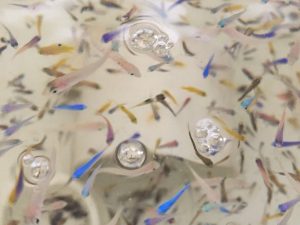Study Finds Low Oil Concentrations Impair Self-Preservation Behaviors in Coral Reef Fish Larvae
– OCTOBER 26, 2017
Researchers from the United States, Australia, and Europe conducted mesocosm experiments to assess how larval reef fishes respond physiologically and cognitively to low crude oil concentrations. The team observed that polycyclic aromatic hydrocarbons (PAHs), at levels recorded in industrialized sections of tropical coral reefs worldwide, increased larvae mortality and stunted growth rates. The larvae exhibited altered habitat settlement and antipredator behaviors that made them more susceptible to predation, including reduced ability to identify a healthy reef with food and hiding places, reduced shoaling (seeking safety in numbers), and increased risk taking (moving away from shelter). These results provide new insights into the impacts of industrial oil pollution in sensitive coral reef ecosystems. The researchers published their findings in Nature Ecology & Evolution: Oil exposure disrupts early life-history stages of coral reef fishes via behavioural impairments.
Coral reefs are among the most threatened ecosystems on the planet, with 19% disappearing in the last 35 years and a further 15% reduction expected in 10-20 years. An estimated 400 million people globally depend on coral reefs for subsistence, and reef ecosystems provide an estimated $30 billion in annual revenue from fisheries and tourism. Most reef fish species experience a pelagic larval phase when they develop traits related to finding a habitat, food, and avoiding predators. Increased mortality during this sensitive stage may have ecological consequences, including a reduced abundance of keystone species.
“LD50 studies (meaning the Lethal Dose where 50% of exposed individuals die) have been used to establish the limits of pollution that are presently acceptable due to industry,” explained study author Jacob Johansen. “However, recent advances in our understanding of toxicants have revealed detrimental responses in many animals at concentrations that are much lower than the LD50 dose required to immediately kill. These revelations sparked the necessity of this low-exposure study.”
Mesocosm experiments used larval fishes (six species spanning two distinct evolutionary families) caught around Lizard Island Research Station in the northern Great Barrier Reef, Australia. Oil-exposure treatments used high-energy water accommodated fractions (HEWAFs) from naturally weathered crude oil (collected in June 2010 in the Gulf of Mexico) for 24 hours. HEWAF solutions contained PAH concentrations (2.5 and 5.7 μgl-1) that can be found in coastal waters and sediments worldwide (0.1 to more than 600 μgl −1 Readman, J.W. et al 2002; Douben, P.E. 2003; Basheer, C. et al 2003; El-Sikaily, A. et al 2003; Jones, R 2010; Kroon, F.J. et al 2015).
Compared to control larvae, oil-exposed larvae grew approximately 10.5% less and had an 11% increase in latent mortality despite unlimited food and no predators. In mesocosms with corals, sand, and coral rubble, 70% to 95% of control larvae preferred high-complexity reef habitats to medium- and low-complexity habitats and completely avoided sand habitats, which provided no refuge. Conversely, 14% to 33% of oil-exposed fish chose the sand habitat with declining settlement frequency on other habitat types. Oil-exposed larvae formed 28% to 35% smaller shoals compared to controls and exhibited a 1.25 to 2.4 fold increase in movement between habitats and time spent in open areas. As a result of these altered anti-predatory behaviors, oil-exposed fish exhibited a 2.7 fold increase in mortality over the approximate 10% predation-related mortality rate seen in controls and under natural conditions.
“It is crucial to fully understand how polluting industrial activities affect sensitive and declining ecosystems. This needs to happen before the perpetual natural and economic value of those ecosystems is put at risk,” said Johansen. “Our study provides a suite of new experimental approaches that can be used to evaluate pollutant impacts beyond the standard LD50 trials.”
Data are publicly available through the Gulf of Mexico Research Initiative Information & Data Cooperative (GRIIDC) at doi:10.7266/N7NK3C36 and doi:10.7266/N7T72FH4.
The study’s authors are Jacob L. Johansen, Bridie J.M. Allan, Jodie L. Rummer, and Andrew J. Esbaugh.
************
This research was made possible in part by a grant from the Gulf of Mexico Research Initiative (GoMRI) to the Relationship of Effects of Cardiac Outcomes in Fish for Validation of Ecological Risk (RECOVER) consortium. Other funding sources included the Lizard Island Research Foundation.
The Gulf of Mexico Research Initiative (GoMRI) is a 10-year independent research program established to study the effect, and the potential associated impact, of hydrocarbon releases on the environment and public health, as well as to develop improved spill mitigation, oil detection, characterization and remediation technologies. An independent and academic 20-member Research Board makes the funding and research direction decisions to ensure the intellectual quality, effectiveness and academic independence of the GoMRI research. All research data, findings and publications will be made publicly available. The program was established through a $500 million financial commitment from BP. For more information, visit https://gulfresearchinitiative.org/.
© Copyright 2010-2017 Gulf of Mexico Research Initiative (GoMRI) – All Rights Reserved. Redistribution is encouraged with acknowledgement to the Gulf of Mexico Research Initiative (GoMRI). Please credit images and/or videos as done in each article. Questions? Contact web-content editor Nilde “Maggie” Dannreuther, Northern Gulf Institute, Mississippi State University (maggied@ngi.msstate.edu).






